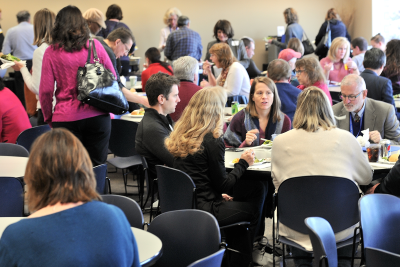be iNFormed about Optic Gliomas
By Dr. Robert Listernick (NF Midwest be iNFormed Series)
Optic pathway gliomas are benign (low grade) pilocytic tumors. They may involve any location in the optic pathway, starting on the optic nerve in the orbit (the eye socket), the optic chiasm (the area of the brain where the two optic nerves come together and intermingle) or the optic tracts and optic radiation which are in the posterior part of the brain. They rarely become malignant/cancerous, i.e. they do not spread to other parts of the body.
If all children undergo MRI scans at the time of diagnosis of NF-1, approximately 15% of the children will be found to have optic pathway tumors (OPT). However, only ½ of these tumors will ever cause problems or cause symptoms. Therefore, the true incidence is approximately 7%. OPT occur in young children with NF-1 with an average age of detection of 4 years. Since the greatest risk period for developing OPT is during the first 8 years of life, children over 10 years of age have an extremely low likelihood of ever developing a OPT.
Children with symptomatic OPT often have abnormal eye exams, primarily decreased vision or proptosis (bulging out of the eyeball). For this reason, it is imperative that NF-1 children under 10 years of age undergo yearly eye exams by ophthalmologists experienced with NF-1. Other children will come to medical attention due to the early development of puberty (precocious puberty). This occurs because OPT which involve the optic chiasm may disrupt normal hormonal function of the nearby pituitary gland. The first sign of precocious puberty is faster than normal growth. For this reason, all NF-1 children should have their height measured yearly and plotted on a growth chart by both their pediatricians and NF doctors.
If your child is diagnosed with an OPT, don’t panic. Progressive disease requiring treatment occurs in about 1/3 of cases. However, it’s impossible to predict what will happen to a specific tumor. In general, tumors that occur in the back part of the optic pathway (optic tracts and radiation) are more likely to progress. Once diagnosed with an OPT, children should be followed with serial eye exams and MRI scans, although the exact intervals vary among institutions.
When progression of symptoms does occur, the decision to initiate therapy varies between institutions and takes into account multiple factors, including the age of the patient, tumor location and tumor growth on MRI scan, the goal of therapy is preservation of vision. Most importantly, decisions to treat should be performed at centers with a multidisciplinary NF-1 team whenever possible.
Parents often ask whether their children should undergo MRI scans. Since approximately 50% of children with OPT never have symptoms at all and the majority with symptoms would never progress, the findings on MRIs may raise unnecessary alarm. Although practices vary between NF-1 centers, most agree that “screening” MRI scans in children who have normal eye exams and their height charted yearly are not necessary.
In 2012, the first-line treatment for NF-1 OPT is chemotherapy, usually with a combination of two drugs- carboplatin and vincristine. This combination is generally very well tolerated; admission to the hospital is rarely necessary. Some children receiving carboplatin will develop hypersensitivity to the drug, sometimes necessitating switching to another agent. Some patients who receive vincristine may develop peripheral (outside of the brain and spinal cord) nerve damage that is often reversible. Surgery is rarely an option for these tumors and is almost only used for cosmetic purposes to remove large tumors in the orbit which have caused a blind eye. Radiation therapy should be avoided in children with NF-1 except in extreme circumstances since it carries a significant risk of damaging blood vessels in the brain or leading to the development of secondary cancers.
Visual outcomes for children with OPT are just beginning to be studied. While preventing the tumor from growing is important, the main goal of therapy is to preserve vision. A recent study which looked retrospectively at vision in children with NF-1 OPT showed that vision improved in 32% after receiving therapy, stabilized in 40% and declined in the remainder. While these results are encouraging, they demonstrate that we need to further improve treatment of these children. Future studies will need to address better: 1) standardization of treatment indications, 2) methods for detecting early damage to the visual pathway before irreversible vision loss has taken place, and 3) treatment strategies.
Optic Glioma Summary
- Approximately 7% of children with NF1 will develop a symptomatic optic pathway tumor (OPT).
- It is extremely unusual for an OPT to progress and develop complications or symptoms after the age of 10.
- MRI scans looking for OPT generally are not necessary in children with NF1 unless they have abnormal eye exams or develop unusually fast growth.
- Approximately 35% of children with symptomatic OPT will progress sufficiently to require treatment.
- The goal of treatment is to preserve vision.
- Of those children who require treatment, 75% stabilized or had no decline in vision after treatment.
- It is very important for children with NF1 to be seen regularly by physicians knowledgeable in the management of NF1.





.png)





